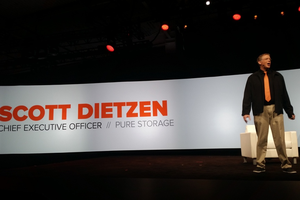Pure Storage IPO: A Look Back

Pure Storage had their IPO a couple of weeks ago, and I'd like to look at it now that most people have moved on to whatever shiny object will capture their attention for the next twelve seconds.
There was plenty of news about the place about how awful the listing was, even though the day one price was solidly in the range. This tells us that a lot of people wanted to read a disaster into the Pure IPO, and when it didn't really happen, they had to downgrade their dire assessment to a resounding ‘meh'.
Look again at the stock price. At the close of Friday, Pure's stock was at $18.84, a full 10% higher than the listing price of $17, and it had gone as high as $20.60 (according to the NYSE page here). If we look at the behaviour of the stock over the past couple of weeks, we can see a strong jump right on the news of Dell's intention to buy EMC.
Let's speculate about what that means. Pure's main competitor is EMC's XtremIO. We know Dell is planning to consolidate storage lines, and there's already plenty of FUD being thrown about by all of EMC's competitors. Investors likely see Pure doing well in this unstable environment, and with the XtremIO team distracted, at least partially, by merger activities.
Now if the stock had jumped to $20 on the day of listing, we would have seen commentary about what an incredibly great result it was (based on what, exactly?), as well as remarks about how a big bump is easy if you under-price the deal and leave money on the table. Given the vagaries of the market, and a relatively volatile stock that has moved 10% in two weeks, getting the listing within the price range of $16-18 seems like pretty good going, to me.
I had a chat with Steve Sararcino, Founder and Partner of Activant Capital, about Pure's IPO a couple of days after the listing, and he was relatively positive about how things went. “It could be construed as a down round, but it's not really,” he said. “It's a great business and it's growing like crazy. Most of the investors made a lot of money.”
Sararcino believes the reason the stock dropped slightly on the day is that the underwriters didn't do a great job at managing the allocations of stock to their clients. “There is great demand for companies growing in excess of 50% with a reasonable cost of customer acquisition,” he said. “Bigger funds have to put money somewhere. As a big money manager, you care about relative performance. A 3% return instead of 2% is much better than 12% instead of 10%.”
Regarding the general mood of the markets, Sararcino says that it hasn't been clear whether private markets have been driving public markets, or vice versa. “In the last few years, it's not been clear who is driving who,” he said. “It's a healthier environment today. Valuations are more realistic. People are a bit more cautious. The balance of power between investors and entrepreneurs is trending back to normal.”
Bring on the next few data points, I say. For all the talk of Big Data and decisions based on facts and analysis, we sure see a lot of breathless headlines and baseless feelpinions.
This article first appeared in Forbes.com here.
